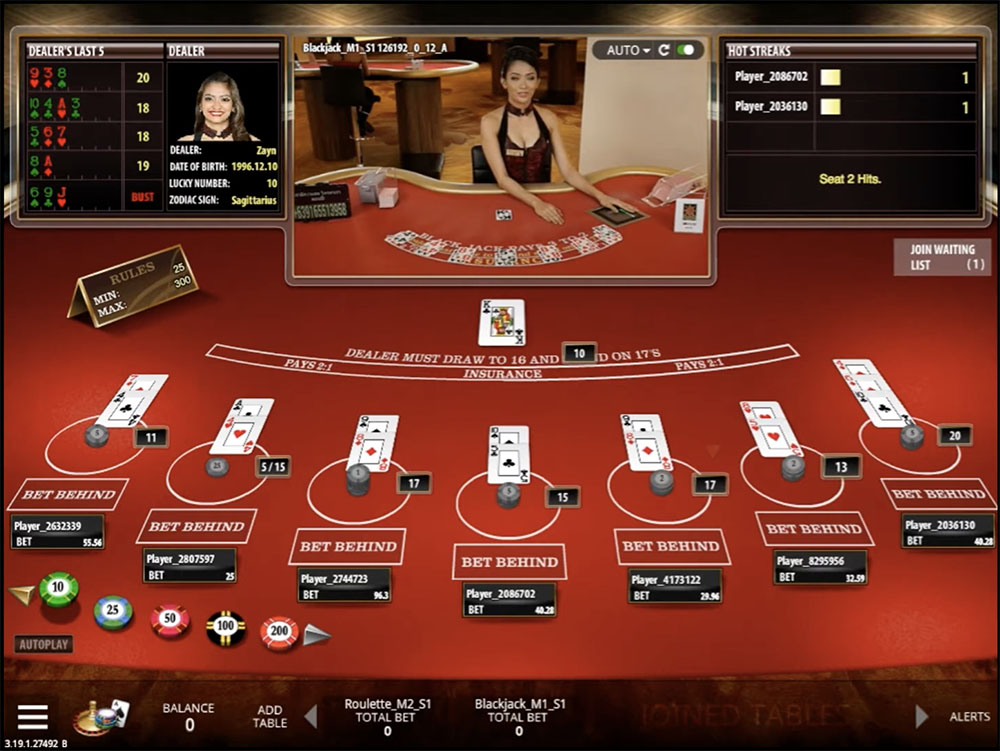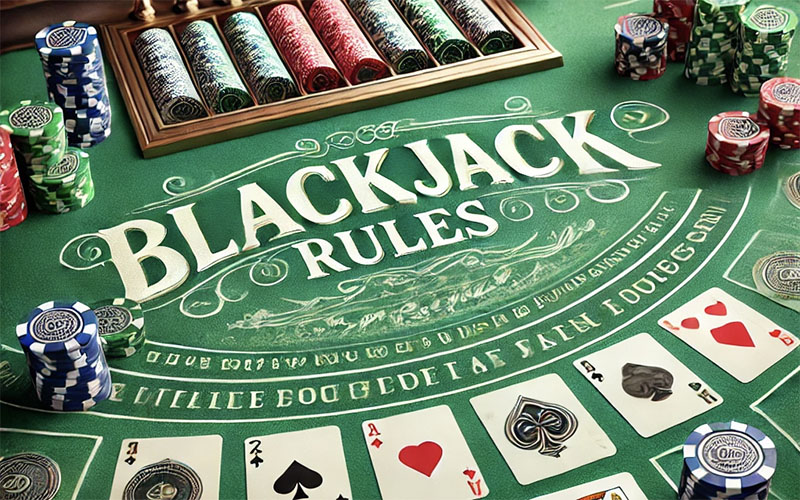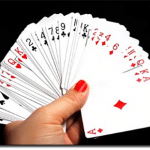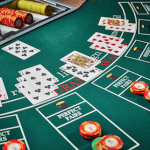The aim of blackjack is to reach 21 without busting and gifting the hand to the dealer. While blackjack rules can vary, depending on where you are playing and what version, they all revolve around the number 21. Our blackjack rules and optimal play guide will run you through everything you need to know to successfully play blackjack, both online and offline.
Blackjack rules
Of all the casino games the world over, blackjack is just about the gambler’s best friend. Unlike some other casino games that rely solely on chance, blackjack is a game, as mentioned several times, where skill, knowledge and concentration are just as important as getting the right cards.
So with the right intel, a sound game-plan and a little bit of luck, we can make a sizeable profit at the 21 tables. Below we will break down the rules of blackjack; including the deal, gameplay (player options), how blackjack insurance works and much more.
The deal in blackjack
In the initial deal in a standard rules variation of blackjack players receive two cards face-up, while the dealer receives one face-up. Players then should have a strong idea of how the game will unfold and whether they should take insurance.
Dealer checks for blackjack
If playing American blackjack, some games, if the dealer’s up-card is an Ace or 10-point valued card, he/she will look at the hole card to check for blackjack – a 21-point hand total made up of an Ace and any 10-point card. If the dealer has blackjack, he/she will reveal the hand, and this immediately beats all other player hands (even those which total 21 in a different combination). If a player holds blackjack when the dealer also reveals the same hand, then the player’s and dealer push (player’s bet is returned without any winnings).
Note: What is important if playing European blackjack, or American versions where the dealer does not check for blackjack, is whether the player stands to lose more than their mandatory, original bet, if the dealer hits blackjack. In these versions, because we do not know whether the dealer has blackjack, it is possible for us to double and split our hands having already (but unknowingly) been beaten by the dealer. If we do stand to lose more than our original bet, we must be more careful when opting to double and split when the dealer has a potential blackjack.
In order to find out more about how standing to lose more than just our mandatory bet when the dealer has blackjack affects our winning chances, refer to our house edge in blackjack guide and read the ‘resulting rules of no hole card or no peeking games’ section, where we discuss ‘original bets and busted only’ (OBBO) and busted bets plus 1 (BB+1).
Player options in blackjack

After the deal, there are a number of actions we can take depending on the make-up of our hand. In land-based casinos, these moves are accompanied by hand signals (this is because most tables are subject to video surveillance, so the casino can keep track of any dealer errors, cheating, and advantage play such as card counting). Under standard blackjack rules player may take the following actions:
- Stand – End your turn and await the dealer’s reveal. When you stand, whatever cards you have make up your final score for that round. The signal is a horizontal wave of the hand.
- Hit – Draw another card, dealt face-up. If you don’t bust (exceed 21 and lose), you can choose to stand or hit again. The signal is tapping the table with your finger. Some games use the Charlie rule, where if you hit a certain number of times (usually five) without busting, you automatically win. It can significantly decrease the house edge.
- Double down – Make an additional bet (equal to your original bet) and draw only one additional card (dealt face-up and turned sideways). After this, you must stand and your turn is ended. The signal is placing the chips for the additional bet as next to and touching your original wager. Read in-depth instructions about doubling here.
- Split – When dealt a pair, you can choose to split the cards to make two separate hands. This requires another bet, usually equal to the first, and can only be played as the first action. The signal is placing the chips for your additional bet next to your original wager, further apart than you would a double (outside the betting box). Browse over our article about splitting to find out about the restrictions on doing so.
- Surrender – In some games, you will have the option to forfeit your hand and half your bet, reclaiming the remaining half. This can only be done as the first action. There are two kinds of surrender: early, where the option is offered before the dealer checks for blackjack; and late, where players can only surrender after the dealer checks for blackjack. The signal is moving your finger from right to left on the table, like drawing an imaginary line (although a verbal request is also required). To learn more about this option and when to perform it, we talk about surrendering in more detail here.
Dealer’s turn
Now that all players have received their second card and completed their hands, the blackjack play moves to the dealer, who receives their second and subsequent cards.
The dealer must hit on hands that total 16 or less and stand on totals of more than 17. Depending on what blackjack rules you are following, sometimes the dealer must hit on a soft 17, which is when the dealer has an Ace and 6 in their hand.
Winning hands and payouts in blackjack
A player with a natural blackjack (an Ace and ten-value card) wins straight away, unless the dealer also has a blackjack, in which case it is a tie and the player receives their money back.
If the dealer has blackjack and no player does, the dealer will sweep the board and take all your chips.
If the dealer in blackjack busts (goes over 21) all players win at the table, that have not busted; while if they are forced to sit on 18, for instance, and there are players who get closer to 21 without busting, they will be payed out accordingly.
Blackjack payouts
A winning blackjack hand is generally paid out at 3:2, although this can change depending on what version of blackjack rules you are playing under.
All other winnings hands in blackjack are paid out at 1:1, while if a player took insurance and the dealer hits blackjack, the insurance pays at 2:1.
Blackjack insurance rules
When the dealer’s up-card is an Ace, there will often be an option to take insurance. Here, you can choose to open a side-bet (usually half your initial bet) at 2/1 odds that the dealer has a blackjack. The idea is that you recoup your losses (ie. you are ‘insured’) if the dealer’s second card turns out to be a Ten or a picture.
For example: our bet is $10, and with the dealer showing an Ace we take a $5 insurance. If the dealer has a blackjack, we lose the initial $10 but gain $10 from the side-bet to come out square. If the dealer doesn’t have a blackjack, we lose the $5 insurance bet regardless of whether we end up winning the hand. If you are dealt a blackjack and the dealer is showing an Ace, you may also be offered even-money insurance. If you take this option, you forfeit the potential 3:2 payout to settle for a guaranteed 1:1 return, regardless of the dealer outcome. For example: we bet $10 and hit a blackjack. The dealer shows an Ace and we opt for even-money. Note we do not need to lay down any more chips when taking even-money, unlike regular insurance. We are simply making it certain that we aren’t subject to a push/tie if the dealer has 21 too, and that we get some return (also known as full insurance, as we are guaranteed a profit). If we take this option, we are paid out immediately.
There is a simple strategy for insurance bets: don’t take them. There are some specific instances where you could justifiably do so (if you count cards, for one) but by and large the numbers suggest you’d be well advised to ignore insurance offers. This is particularly true with even-money: in the long run, you’ll do better hanging out for the 3:2 payout on a blackjack, because the chances the dealer has blackjack are less than one in three. To learn more about why insurance should be avoided at all costs, read why insurance is a sucker bet.
Blackjack rule variations
It would be remiss of us not to have a page detailing the rules of blackjack on a site with the domain name blackjack.com.au. Blackjack is a variation of 21, which covers a broad range of card games that have been played in continental Europe since the 17th century. The object of the game is to beat the dealer by scoring more points in a hand without exceeding 21. Cards are scored by their numerical ranking, with all picture cards (Jacks, Queens and Kings) worth 10 points. Aces can play as one point or 11, depending on which number benefits the player best.
A typical casino-style game uses between one and eight standard decks of 52 cards, which are shuffled together. A table can often hold up to seven people, although most online games are one-on-one affairs with a single player and a dealer.
- American blackjack: After bets are placed, all players, (starting from the left of the dealer), are dealt one up-card, the dealer then receives one card face down, players then receive their second up-card. The dealer then draws his/her second card face down (hole card), flips over his/her first-dealt card, and places the hole card under the now visible up-card. All players now play out their hand in turn, in the same order they were dealt. Once finished, the dealer turns over his/her face down card, and draws or stands according to the set rules (detailing below).
- European blackjack: After bets are placed, all players (starting from the left of the dealer), are dealt one card face up, the dealer then draws one up-card, and players are then dealt a second face-up card. The dealer does not draw a hole card, but instead allows players to play out their turn, and only after all have completed their turns, draws him/herself a second up-card.
Note: In these distinct versions, the order of the deal has merely been changed, and neither way is more or less advantageous. However, the resultant rules which come with the European way of dealing affect the player (as explained below).
Optimal Strategy in blackjack
There are endless variations to blackjack rules, actions and dealer instructions that can have a significant impact on optimal strategy.
For our purposes, we’ll base our tactical advice on a fairly stock-standard set of blackjack rules:
- Between four and eight decks in play
- Dealer stands on all 17s (soft and hard)
- Doubling down is allowed after splitting
- Dealer checks for blackjack
Note that the following blackjack strategy is the ideal way to play outline; what to do with any soft or hard total you might have (or pairs). For the most simple of simple advice on when to hit and stand, read over our general blackjack strategy guide.
Charts explaining basic blackjack strategy are all over the web, and are useful for those who get more out of a diagram than they do reading content. But we know many people aren’t that keen on diagrams and prefer a step-by-step list of what to do. So what we have created below is a written format which translates those charts in to plain and simple English.
For tips on what not to do, read our guide to bad blackjack strategy.
Note: When we say Ten, we are referring to a Ten and all face cards (J, Q and K).
How to play blackjack hands
Below we will break down how to play specific blackjack hands, including hard hands, soft hands and pairs.
Hard Hands
A hard hand is one without an Ace, or where an Ace can only be played as one point. For example: K, 5, A is called a ‘hard 16’ because if you played the ace as an 11, you would bust with 26. As hard values are set in stone, they come with a similarly rigid instruction manual on how to play each one. Below is a run-down of what to do when you are dealt hard hands in a standard blackjack game. Most actions are influenced by the value of the dealer’s up-card.
Hand total of eight or less – Always hit.
Hand total of nine – Double down if dealer’s up-card is a Trey through to a Six (hit if doubling is not allowed at that stage). If any other card, hit.
Hand total of 10 – Double if dealer shows a Nine or lower (hit when you can’t double). If dealer shows a Ten or Ace, hit.
Hand total of 11 – Double if dealer shows a Ten or lower (hit when you can’t double). If Ace, hit.
Hand total of 12 – Stand if dealer shows a Four through to a Six, otherwise hit.
Hand total of 13 or 14 – Stand if dealer shows a Six or lower, otherwise hit.
Hand total of 15 – Stand if dealer shows a Six or lower. If 10, surrender if allowed, otherwise hit. For any other card, hit.
Hand total of 16 – Stand if dealer shows a Six or lower. If Seven or Eight, hit. If Nine or higher, you can surrender if allowed, otherwise hit.
Hand total of 17 or higher – Always stand.
Soft Hands
A soft hand contains an Ace that can play as either a one or an 11. For example: the hand of Ace and Eight is a ‘soft 19’ because it can be rated as either 19 or nine. As the values of soft hands are flexible, they carry a different set of strategic options when compared to hard hands
Ace and a Deuce, or Ace and a Trey (soft 13/14) – Double if dealer shows a Five or Six (hit when you can’t double). If any other card, hit.
Ace and a Four, or Ace and a Five (soft 15/16) – Double if dealer shows a Four through to a Six (hit when you can’t double). If any other card, hit.
Ace and a Six (soft 17) – Double if dealer shows a Trey through to a Six (hit when you can’t double). If any other card, hit.
Ace and a Seven (soft 18) – Double if dealer shows a Trey through to a Six (stand when you can’t double). If dealer shows a Nine or higher, hit. If dealer shows a Deuce, Seven or Eight, stand.
Ace and an Eight, or Ace and a Nine (soft 19/20) – Always stand.
Pairs
When dealt a pair, the option to split gives you more strategic leeway than with non-paired soft or hard hand. While it is often best to divide such a hand into two, as it gives you a chance to win twice as much, there are some pairs that are better off left together (two Tens, for instance).
A pair of Deuces or Treys – Split if the dealer shows a Seven or lower. If Eight or higher, hit.
A pair of Fours – Split if dealer shows a Five or Six, otherwise hit.
A pair of Fives – Double if dealer shows a Nine or lower (hit when you can’t double). If 10 or Ace, hit.
A pair of Sixes – Split if dealer shows a Six or lower, otherwise hit.
A pair of Sevens – Split if dealer shows a Seven or lower, otherwise hit.
A pair of Eights – Always split.
A pair of Nines – Stand if dealer shows a Seven, Ten or Ace. If any other card, split.
A pair of Tens – Always stand.
A pair of Aces – Always split.
Note: Once your cards are split and you are dealt an additional card for each hand, refer to the above strategies (for whatever your new hand might comprise of) to play out the hand.
Additionally, if you can’t split because there is a limit on re-splits, then follow the strategy where you consider your hand a hard total. Furthermore, this detailed strategy should always be your first point of reference. If playing a game where the dealer hits on a soft 17, there are some minor differences, but none which will have detrimental effects of your chances, so using the above strategy is perfectly fine. It has been calculated that the cost, in terms of errors, is around two-and-a-half times higher if we play a ‘stand on soft 17’ game with the ‘hit on 17 strategy,’ than the other way around.
For more tips, check out these detailed blackjack strategy guides:
- When to hit and when to stay in blackjack
- Managing your money at the blackjack tables
- What to do when the dealer shows a six
- What to do when dealer up-card is a seven
- When to stay away from the blackjack tables
- When not to play blackjack
- Wrong way to play 21
- Blackjack superstitions
- Five times going all in paid off




